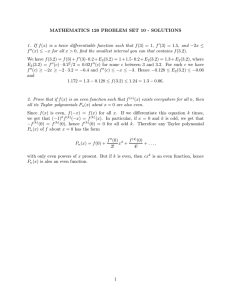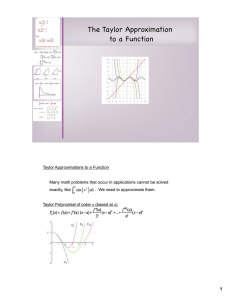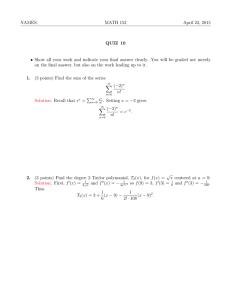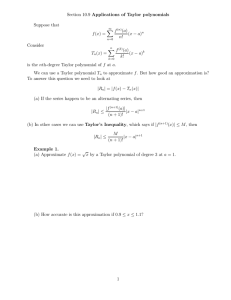Computer Lab #2: Taylor Polynomials
advertisement
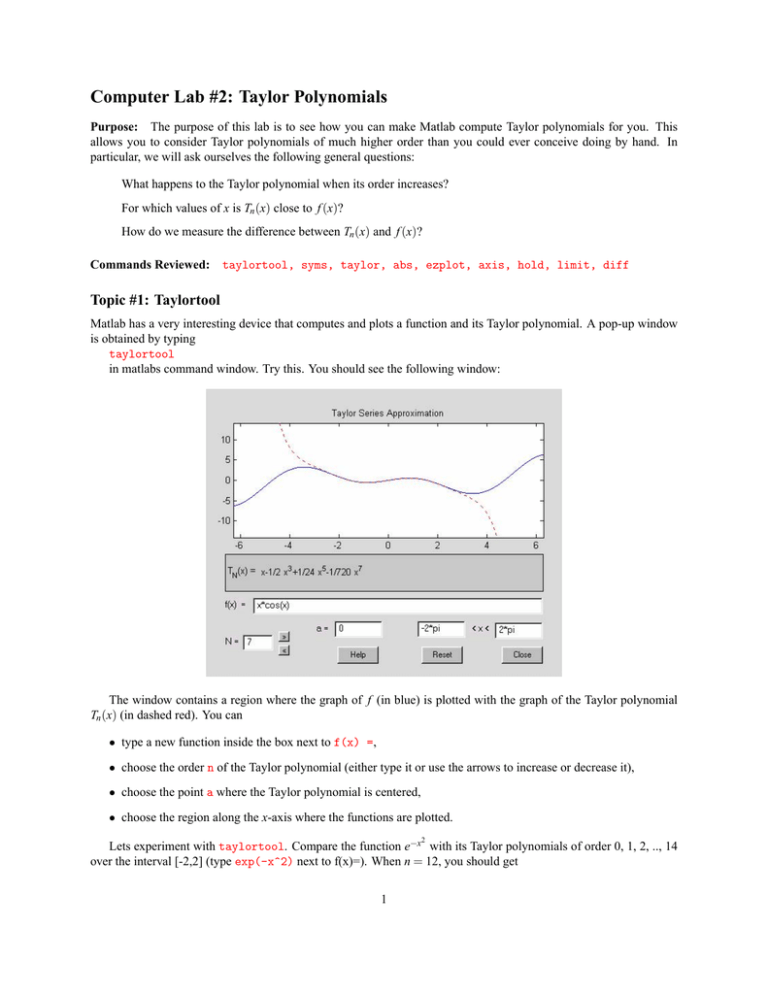
Computer Lab #2: Taylor Polynomials Purpose: The purpose of this lab is to see how you can make Matlab compute Taylor polynomials for you. This allows you to consider Taylor polynomials of much higher order than you could ever conceive doing by hand. In particular, we will ask ourselves the following general questions: What happens to the Taylor polynomial when its order increases? For which values of x is Tn (x) close to f (x)? How do we measure the difference between Tn (x) and f (x)? Commands Reviewed: taylortool, syms, taylor, abs, ezplot, axis, hold, limit, diff Topic #1: Taylortool Matlab has a very interesting device that computes and plots a function and its Taylor polynomial. A pop-up window is obtained by typing taylortool in matlabs command window. Try this. You should see the following window: The window contains a region where the graph of f (in blue) is plotted with the graph of the Taylor polynomial Tn (x) (in dashed red). You can • type a new function inside the box next to f(x) =, • choose the order n of the Taylor polynomial (either type it or use the arrows to increase or decrease it), • choose the point a where the Taylor polynomial is centered, • choose the region along the x-axis where the functions are plotted. 2 Lets experiment with taylortool. Compare the function e−x with its Taylor polynomials of order 0, 1, 2, .., 14 over the interval [-2,2] (type exp(-x^2) next to f(x)=). When n = 12, you should get 1 With a few clicks of your mouse you can see that the graph of the Taylor polynomial Tn appears to approach the graph of f . In fact, according to taylortool, for values of x near to a, the graphs look virtually identical. Question #1 a) Examine the Taylor polynomials of cos(x) centered at a = 0 over the interval [−2p, 2p]. What happens as the order n increases? When do the graphs become identical? b) Why is the Taylor polynomial of order 2 equal to the Taylor polynomial of order 3? c) Start over with Taylor polynomials centered at a = 2 and for an interval of width 4p centered at a, i.e. [2 − 2p, 2 + 2p]. When do the graphs seem to be identical? d) If you consider the larger interval [2 − 3p, 2 + 3p] and plot Taylor polynomials centered at a = 2, for what order Taylor polynomials do the graphs seem to be identical? e) In words, describe how the graph of the Taylor polynomial is approaching the graph of f . f) Give a geometric interpretation of T0 and T1 and relate it to the graph of cos(x). Topic #2: Computing the error In the previous exercises, we claimed that f was close to Tn when the graphs overlapped. Well try to be more precise about the closeness between these two graphs. We know how to measure the distance between the values of f and Tn at a point x. This distance is | f (x) − Tn (x)| . On the other hand, f and Tn are defined over an interval [a, b] and for some choices of x, this distance may be large while for some other values of x this distance may be small. What do we do when have to consider a whole range of values for x? Take the largest one! 2 Definition The error between f and its n-th order Taylor polynomial over the interval [a, b] is the maximum value of | f (x) − Tn (x)| (∗) when x belongs to [a, b]. In practice, the quantity (∗) is a function of x and by plotting it we can estimate its largest value. Lets do this for cos(x) and its Taylor polynomial of order 4. Type the following: syms x f=cos(x); t4=taylor(f,5) % yes, 5 not 4 !!1 ezplot( abs(f-t4) ,[-2,2]); What do these matlab commands represent? The expression t4 is the 4-th order taylor polynomial for f . The abs command stands for absolute value. The ezplot command plotted the function (∗) over the interval [−2, 2]. Unfortunately, we cant see the largest value of the graph because it blows up near the ends of the interval. Lets resize our screen with the axis command. Try axis([-2,2,0,0.1]); Now we can see that the graph of the function (∗) is always smaller than 0.09. Therefore we claim that the error between f and T4 over the interval [−2, 2] is less than 0.09. Using taylortool, you could check that the graphs of f and T4 over the interval [-2,2] are very close and therefore that the error between f and T4 should be small. Question #2 In this question we will look at the distance between f (x) = at 0. 1 and its Taylor polynomials centered 1 + x2 a) Use the taylor command to find the Taylor polynomials of order 1, 2, 3, 4, and 5. How are they related to the power series representation for f given above? b) What is the interval of convergence of the power series representation of f given above? c) Graph f over the interval [−2, 2]. On the same plot (using the hold on command) draw the Taylor polynomials of order 2 and 3. d) Over the interval [−.5, .5] measure the error between f and Tn for n = 5, 10, 20, 40. Graph the four functions (∗) on the same graph. Make a table of this error. e) Repeat question d) but over the interval [−.75, .75]. f) Repeat question d) but over the interval [−1, 1]. g) Describe the convergence of the Taylor polynomials to the function f . Where and how does it converge. Note: This example should make you wonder. The function f is smooth at x = −1 and x = +1 (continuous, differentiable, etc.) but the Taylor polynomials are doing something funny at those points. Can you guess why the Taylor polynomials might be acting funny at or near x = −1 and x = +1? Topic #3: A Function and its Taylor Polynomials We will now study a very famous function. We wont give the punch line away so please bear with us. −1 Consider the function f (x) = e x2 . To graph this function over the interval [−10, 10], type syms x f=exp(-1/x^2); 1 If you want the n-th order Taylor polynomial, then you have to type taylor(f,n+1). 3 ezplot(f,[-5,5]); Notice that even though f is not defined at x = 0 the graph of f is well defined at x = 0. Notice also how flat the graph of f is near x = 0. Now try graphing it over the interval [−1, 1]. Because the graph of f is flat near x=0, we expect that its derivative (and maybe all or a bunch of its derivatives) to be zero at x = 0. This is what we will check. Unfortunately, we have a problem. The function f is undefined at x = 0. You can see immediately that the exponent -1/x^2 cannot be computed when x = 0. On the other hand, this function makes sense for all other values of x. The key observation is that although the formula defining the function fails when x = 0, in fact the limit of f (x) as x goes to 0 exists, i.e. lim f (x) exists. What we would sort of like to do is to define a new function F, where F(x) = f (x) for x→0 x 6= 0 and F(0) = lim f (x) (which from the graph we would guess is 0 — and hopefully by computing this limit). The x→0 following matlab command allow you to compute the limit of f (x) as x approaches 0. limit(f,x,0) Hence we will repair the definition of f (and still call it f instead of F) by agreeing that f (0) is equal to this limit. Our function is now defined for all x, moreover it is continuous. Moreover, the derivatives of f can be computed for all x 6= 0 and their limits at x = 0 are also well-defined. df1=diff(f,1) % first derivative limit(fp,x,0) df2=diff(f,2) % second derivative limit(df2,x,0) Although the formula for f is technically not defined when x = 0, it is natural to choose the value of f (n) (0) as lim f (n) (x). x→0 For the same reasons as before, the derivative is now defined for all x and it is continuous. We can therefore compute its Taylor polynomial centered at a = 0. The command taylor(f,3) will give you an error because the computer doesnt know how weve defined the function at x = 0. We are going to have to compute the Taylor polynomial the hard way. Question #3 a) Compute the value of f (n)(0) for n = 3, 4, 5, , 10. (Remember, when we refer to f here, refer to the adjusted f — defined at x = 0 by taking the limit.) Make a guess for the value of f (300) (0) and check it. b) Using your guess from a), compute the Taylor polynomials and the Taylor Series for f . c) Compute the error between f and Tn over the interval [−1, 1] for n = 1, 2, 3, , 10. d) Do the Taylor polynomials approach f as n increases? 4
